’02 Working Conference of the Academy
The
Annual Working Conference of the Chinese Academy of Sciences closed in
Beijing on January 24th, 2002. The meeting laid out the
priorities for this year.
Academy
President Yongxiang LU positively appraised the meeting. He appealed
that the academy should properly deal with the relations between reform,
de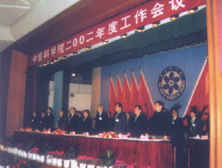 velopment
and stability, open up a new phase of the Pilot Project of Knowledge
Innovation Programme (PPKIP), steer every piece of work according to
the guidelines of the Academy in the new phase, carry out with greater
efforts the Strategic
Action Plan of S & T Innovation so as to
upgrade the entire innovative ability of the Academy, enhance the building
of leadership and innovative contingent, facilitate the training of
leading cadres, optimize the echelon of leadership, and adjust the Academy’s
personnel strategy to the increasingly competitive environment.
At the meeting, 26 institutions such as the State Key Laboratory
for superconductors under the Institute of Physics were conferred upon
the honor of “Advanced Collectives of CAS” by the Ministry of
Personnel and CAS. Meanwhile, 17 persons including Jiaguang MA et al
from the Chengdu Institute of Photoelectronic Technology were granted
the honor of “Advanced Researchers of CAS”. velopment
and stability, open up a new phase of the Pilot Project of Knowledge
Innovation Programme (PPKIP), steer every piece of work according to
the guidelines of the Academy in the new phase, carry out with greater
efforts the Strategic
Action Plan of S & T Innovation so as to
upgrade the entire innovative ability of the Academy, enhance the building
of leadership and innovative contingent, facilitate the training of
leading cadres, optimize the echelon of leadership, and adjust the Academy’s
personnel strategy to the increasingly competitive environment.
At the meeting, 26 institutions such as the State Key Laboratory
for superconductors under the Institute of Physics were conferred upon
the honor of “Advanced Collectives of CAS” by the Ministry of
Personnel and CAS. Meanwhile, 17 persons including Jiaguang MA et al
from the Chengdu Institute of Photoelectronic Technology were granted
the honor of “Advanced Researchers of CAS”.
|
-
Important Progress in Ion Liquid Research
novel
environment-friendly reactive medium and catalyzer, ion liquid, has
attracted great attention in many fields such as fine chemistry and
organic synthesis. Important
progress has been made by the research group headed by Prof. Youquan
DENG, Lanzhou Institute of Chemistry, CAS in the applied research of ion
liquid for cleaning and catalyzing, i.e., the Backmann’s rearrangement
of cyclohexanone oxime in ion liquid environment was realized for the
first time in the world. In the meantime, the research group headed by
Prof. Weimin LIU took the lead in synthesizing three kinds of liquid
lubricants, discovering that ion liquid is a novel liquid material with
good lubricant performance,
low steam pressure and wide range of applicable temperature.
The
research results have been filed for 4 patent inventions in China, and
more than 20 papers were published on such important periodicals as
Chem. Comm. and New J. Chem.
|
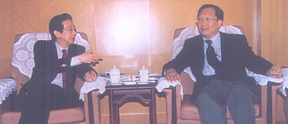
|
CAS President Yongxiang LU, as head of the Chinese delegation, attended
the Japan-China Meeting on Information Technology, which was held in Tokyo
in mid December 2001 and jointly organized by the China-Japan Association
for Scientific & Economic Exchange of CAS, the Japanese Science and
Industry Technology Exchange Agency and the Japan-China Association. |
-
-
Major Results Achieved in Early Mammal Research
|
Fossils
excavated in Lufeng, Yunnan Province indicate that hadrocodium
lived 195 million years ago at the early Jurassic Period, pushing back the
history of such mammals by 45 million years.
The
discovery, jointly made by Prof. Ailing SUN with the Institute of
Palaeovertebrate and Palaeoanthropology, CAS and Dr. Rogers with the
Museum of Natural History, Pennsylvania, USA, was published on Science on
May 25th, 2001. The newly discovered mammal is the smallest
known species that lived during the Mesozoic Era, It is characterized by
that it had the middle ears just as existing mammals. As far as we know,
there are three auditory ossicles in the middle ear of present-day mammal,
one of the important features distinguishing it from reptiles (whose
middle ear only has one auditory ossicle), The existence of the three ear
bones has greatly improved the hearing function of mammals. Before the hadrocodium
is discovered, fossils of mammals’ middle ears with three
auditory ossicles had been found only in rocks at the late Jurassic Period
about 150 million years ago. The discovery has, therefore, pushed back the
history of mammals by 45 million years to the early Jurassic Period.
Because of the similar structure of middle ears, hadrocodium is
believed to have an intimate relationship with existing mammals.
|
Symposium
on Inter-Disciplinary Projects of Life Science and Information Science Held in
Shanghai
|
Symposium
on inter-disciplinary project of life science and information science
under the sponsorship of the National Research Programme in Key Basic
Areas (“973” Programme) was held at the Institute of Biochemistry and
Cytology, Shanghai
Academy of Life Science,
CAS on January 19th , 2002. The purpose of the meeting was to
identify the inter-disciplinary project of life science and information
science. It was aimed at that the project should be original, novel and
operable, and adaptable to the needs of China’s population and health
development, and that it should make full use of the advantages of various
disciplines, with an inter-disciplinary and complementary nature and an
international leading level.
The
symposium published several reports, including “Gene Expression and
Recognition”, “Some Aspects of Bioinformatics Data Procession”,
“What Data Mining can help Bioinformatics”, “Data Mining for DNA
Analysis”, “Proteinomics .Research ”, etc..
|
Research
& Development
Special
Optical Filming Material Developed to Attain Advanced World Leading Levels
|
A
special optical filming material, a high-pure magnesium fluoride, which is
suitable for anti-forgery of paper currency and may be used as a
substitute for import material, has been officially authenticated in
Changchun recently. Experts unanimously
agreed that the product developed
by the AoPu Photo-Electronic Corporation, Changchun Institute of Optics
and Fine Machinery, CAS, has filled a gap in China and reached the
advanced international level.
The
high-pure magnesium fluoride is an important optical filming material in
the fields of optical lens, laser units, integrated optics and optic fiber
communication. Especially in recent years, with the deep-going development
and utilization of optical filming material, magnesium fluoride filming
material has been taken an important raw material for anti-forgery of
paper currency technology and attracted more and more attention.
The
problem of raw material purity has been solved by using various processes
such as vacuum smelting, so a special high-pure optical filming material,
magnesium fluoride, is developed. The purity of the product reaches
99.99%. Besides, the production process of magnesium fluoride has matured,
and it attains or surpasses the technical level developed by the world
major companies such as Canon. |
 |
On 4 March 2002, CAS Vice President Chunli BAI (middle) met with Mr.
Kaifu Nobuo (left), Director of the Japan National Astronomical
Observatory and his wife .
|
ChinaFishBase
Launched
|
Not long age, a contract on the project of
ChinaFishBase, a Chinese fish bio-information database and
consultation system under the National High Technology Development
Programme (“863” Programme), was signed between the Institute of
Hydrobiology, Chinese Academy of Sciences and the Ministry of Science and
Technology, marking the official launching of the R & D project on
fish bio-information database in China.
With an accumulation
of research experience of 70 years about ichthyology, the Museum of
Freshwater Fish, Institute of Hydrobiology, CAS |
has collected over
1,000 freshwater fish specimens in China and more than 260 pattern
specimens, which are regionally complete, say, the freshwater fishes in
East Asia, in the Qinghai-Tibetan Plateau and in the Yangtze River Basin
respectively. In addition, the Museum has over 600 specimens both from
home and abroad for comparativestudy.
All these collections
are unique in the world. Once they are integrated into a network database,
their scientific contribution will be greatly heightened.
|
China’s
Ancient-Lake Database at the Late
Quaternary Period
|
The
research work on China’s Ancient-Lake Database by the Nanjing Institute
of Geography and Limnology (NIGL), CAS has attracted the attention from
PAGES, a well-known international scientific organization. At the
conference held by the Organizing Committee of PAGES in Singapore in
November 2001, the China’s Ancient-Lake Database established by the NIGL
was listed as an important scientific achievement by PAGES.
The
climate environment in the past 20,000 years is a hot subject of the
international research community. China is an early bird in conducting
research on the subject and many of her research outcomes are at the
international leading level. However, the major efforts of the Chinese
community were focused on the collection of geological data, and little
attention was paid to the study of the dynamic mechanism of climate
change. As a result, the knowledge and prediction of climate change is
relatively poor in China. In view of the abundant geological evidence on
the Quaternary Period in China and the weakness in linking the evidence to
climate modeling, the NIGL, represented by Prof. Ge YU, started the
research project, Database on China’s lakes at the late Quaternary
Period and dynamics of palaeoclimate, which was sponsored by the
“Hundred Talent Program” of CAS. |
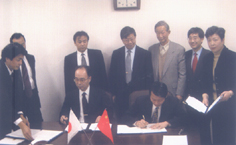
|
An agreement between China and Japan on
cooperation in eco-environment research in arid regions was signed in
Tokyo on 9 December 2001 by Juliang QIU, Executive Deputy-Director General
of the Bureau of International Cooperation, CAS and JSPS, Board Member of
the Japanese Society for Promoting Science. |
Fast
Root-Control Seedling Technology Jointly Developed
|
After
three years of effort, the Institute of Water & Soil Conservation (IWSC),
CAS, in cooperation with the Endack Group (Australia) and Pangu Group
Corp.(Inner
Mongolia),
has successfully developed the Fast Root-Control Seedling Technology,
which has broad prospects of application in plantation, water and soil
conservation and eco-environment rehabilitation.
Root-Control
Seedling is a new technology focusing on regulating the growth of the root
system. It controls the growing direction, size and shape of the plant
root system artificially by providing a special physical environment
(root-control container), a chemical environment (special synthetic
culture medium) and management techniques, so as to create favorable
conditions for the development of seedlings and the growth of the
transplants. The number of roots increases progressively and
exponentially. Experts from Australia and IWSC carried out experiments on
six Chinese arbors, including lace bark pine, Chinese pine, elm, pagoda
tree etc. and several shrubs such as sea buckthorn in southern Australia
and on the Loess Plateau of China,respectively. Results show that, in
comparison with conventional technology, the root-control technology
raises the survival rate of seedlings by 3-4 times and increases the total
root weight by 30-50 times; in the meantime, it shortens the breeding
period by half and reduces the management procedures by 50%-70%, marking a
major breakthrough in breeding technology as compared to seedling raising
with traditional field and conventional container. |
Zhu
CHEN Encourages Young Leaders to Shoulder Heavy Burdens
|
From
10 to 12 December 2001, CAS Vice President Zhu CHEN inspected the
Academy’s Shenyang Institute of Applied Ecology (SIAE), Institute of
Metals Research (IMR) and Shenyang Institute of Automation (SIA),
accompanied by Tao YIN, Vice President of Shenyang Branch, CAS, and held
talks with leaders of the institutes in Shenyang.
After
years of efforts, the majority of the Academy’s institutes have
fulfilled the goal of “intergenerational shift”(shift of heavy burdens
from the elder generation to the younger one), Chen said. A number of
young researchers have undertaken the leadership of institutes. Facing
with both the pressures of scientific research and management, they feel
heavily burdened. Too much pressure is not good, nor is without pressure.
A successful institute director must know what to do and what not to do.
He must play an important role as a deputy director and focus his
attention on major issues rather than minor ones. He must not only take
into account the institute’s development in the long run, but also
consider many other things, such as the state of health and psychological
status of the researchers, their working environment and living
conditions. Maybe in 20 years, China will enter the list of developed
countries in advance. At that time, our successors will carry on the job
on our shoulders to make greater contributions to the scientific
undertakings of the country.
|
Information
Technology
Joining
Hands to Create Virtual Man
|
Experts
from the Institute of Computing Technology, CAS, the No.1 Medical
University of PLA and the Capital Medical University are joining hands to
create a 3-D computer model of the human body that has the shape, bones,
muscles, organs and blood vessels of a typical Chinese, and simulates the
behaviors of a real man.
“Key
technologies for a digital virtual human body” has been approved by the
Ministry of Science and Technology as a project under the National High
Technology Development Programme (“863” Programme) during the
“Tenth Five-Year Plan” Period. The objective of the project is to
acquire all the standard data of an oriental and complete two digital
human body databases (male and female) characteristic of a Chinese on the
basis of the existing attainment by joining the efforts of experts in life
science and information science.
The
human body is a complicated integrity consisting of over 1,000 trillion
cells. The nerve system in the human body alone comprises approximately
100 billion neurons. With the progress of the Human Genome Programme, it
is fully possible to digitalize and visualize the structures and functions
of the human body both microscopically and macroscopically, to depict the
morphology and functions of genes, proteins, cells, tissues and even
organs in detail, and finally to realize a precise simulation of entire
human body by computer graphic technologies in combination with clinical
anatomy.
|
Sino-US
Collaboration in Building “ChinaScience” Website
|
A
cooperative agreement between the Centre of Computer Network Information (CCNI),
CAS and the A & M University, Texas, USA was signed in Beijing on 9
November 2001, laying down a foundation for the bilateral collaboration in
building the virtual library of “ChinaScience” in English and the
long-term cooperation in science publicity via Internet.
The
“ChinaScience” website is hosted by the CCNI under the sponsorship of
CAS. It is aimed at establishing a large network of virtual libraries
covering knowledge of every field by incorporating the information
resources of the Academy’s scientific databases and taking advantage of
the human resources of CAS including scientists and engineers.
As
early as at the end of 2000, a preliminary cooperative agreement had been
reached between ChinaScience and A & M University on the joint
development of the English version of the website and its mirror in the
US, under the support of the National Science Foundation of China (NSFC),
the National Science Foundation of the US (NSF) and the CAS. |
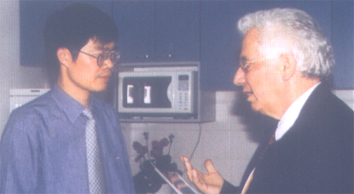
|
Huiming
CHENG, Deputy-Director of SIMR/CAS, talking with Prof. M. Ruhle, Director
of the Institute of Metals, MPG, head of the German delegation |
Progress
in Implementing Go-West Strategy
|
In
order to implement the National Strategy of West China Development (or
Go-West Strategy), the Academy has carried out a series of scientific
research in fundamental, strategic and forefront areas in the past two
years with marked progress.
According
to CAS Vice President Yiyu CHEN, the Academy has initiated research
projects of various levels to address the evolutional process, mechanism
and trends of the eco-environment in the western regions, so as to provide
historic and realistic basis for decision-making in the Go-West campaign.
So far, the Academy has launched eight key projects with a total fund of
123 million yuan. Under the “West Action Plan” of the Academy,
key projects such as “Research on the environmental evolution,
ecological rehabilitation and sustainability of resources in the western
China” were launched. Different strategies and technologies were
proposed and carried out for rehabilitating varied types of damaged
ecosystems in the west to provide theoretical and technical support for
the ecological rehabilitation and sustainable development of resources in
the region, which promoted the adjustment of the industrial structure of
the west and the formation of the high-tech support system for west
development. In addition, the Academy has initiated and implemented
so-called “Light of the West”, a talent training program. |
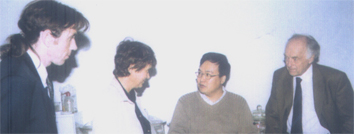
|
Prof.
Niels Hansen (first right), director of the Denmark National Laboratory
RISQ and Prof. Dorte Juul Jensen (second left), deputy director, visited
the Shenyang Joint State Key Laboratory of Materials Science, SIMR/CAS,
from 22 to 25 November 2001 |
CAS-JSPS
Collaboration in Providing Scientific Basis for and Technical Approaches to West
China’s Ecological Rehabilitation
|
During
his visit to Japan in December 2001, CAS President Yongxiang LU signed
with the Japanese counterpart an Implementation Program for Exchange and
Cooperation in Arid-land Eco-environment Research between CAS and Japan
Society for the Promotion of Science (JSPS). The two sides plan to conduct
a 10-year trans-institutional and trans-regional collaboration beginning
from 2002.
The
project will perform collaborative research centering around such issues
as the degradation of Loess Plateau soil due to drought, wind and water
erosion, the desertification of land in the northern China, and so on. It
is of great significance to facilitate research on the control of
declining productivity in arid region and desertification. Besides, it
will contribute to perfecting the theory on rehabilitation of degenerated
ecosystems, developing ecology on soil conservation and restoration as
well as exploring integrated technologies for eco-environment renovation
and reestablishment. |
International
Cooperation
Joint
HT-7 Experiment in Winter
|
In
the winter of 2001, the HT-7 experiment was going on at the Hefei
Institute of Plasma Physics, CAS. An international allied force of
scientists from China, USA and Japan were working together at the HT-7
Laboratory to conduct joint experiments on nuclear fusion.
The
“international allied force ” consisted of 18 foreign scientists from
14 overseas universities and scientific institutions, including the
University of Texas (USA), the University of Tokyo, Tsukuba University,
Shizuoka University, Kyushu University, Kyoto University and the Institute
of Nuclear Fusion (Japan), etc., and 14 Chinese scientists from 11
domestic universities and institutes, such as the Institute of Plasma
Physics, the Institute of Physics, the Southwest Institute of Physics, the
University of Science and Technology of China, Tsinghua University,
Tianjin University and so on.
Recently,
scientists from USA and Japan have fulfilled their tasks and returned home
successively, while the HT-7 experiment still continues at the Institute
of Plasma Physics.
|
Joint
Project on Clean Energy for the Future
|
On
the evening of 10 January 2002, the press conference of the CAS-BP joint
research project on clean energy for the future was held ceremoniously at
the Beijing Hotel.
British
Ambassador to China, the BP Company and CAS leaders attached great
importance to the project and showed full confidence in the success of the
cooperation. They spoke highly of the Dalian Institute of Chemical Physics
(DICP), chief undertaker of the project.
The
project will be dedicated to research on clean energy for the future, and
the objectives in its initial phase include research on energy strategies,
preparation of synthetic gas, improvement of F-T catalytic process, direct
conversion of methane to aromatic hydrocarbon, as well as research on
highly efficient hydrogen storage materials and novel membrane materials,
said Xinhe BAO, director of the DICP at the conference. |
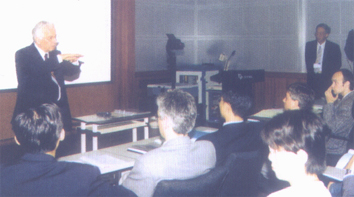
|
A
Sino-German bilateral symposium was held at the Shenyang Institute of
Metals Research (SIMR), CAS from 23-27 May 2001. Prof. M. Ruhle was
delivering a presentation at the meeting |
Sino-Belgium
Collaborative
Project Launched
on Environmental Biotechnology for Sustainable Water Treatment
| A
Sino-Belgium collaborative project, Environmental biotechnology for
sustainable water treatment, which is undertaken by the Shenyang
Institute of Applied Ecology (SIAE), CAS, has been launched officially. 6
scholars of a Belgium delegation from the Ghent University and Leuven
University visited recently, the SIAE to exchange the progress of the
project and discuss the potentiality of enlarging the cooperative scope
and research fields.
In
the past decade, environmental biotechnology has developed speedily and
become the most effective approach to addressing the complicated issues of
environmental pollution. The cooperative project deals mainly with the
following problems: 1. New technologies for anaerobic treatment of
township household wastewater; 2. Oxygen-limited denitrification
technologies; 3. Technologies for producing high quality drinking water
and process water by various membrane skills, and feasibility of applying
them in China; 4. Using molecular biotechnology to develop probes for
determining the characteristics of microbes in anaerobic reactors and for
rapid assessing the sanitary quality of drinking water and process water. |
Cooperative
Agreement Reached between IMR/CAS
and RIS
|
From 22 to 25 November, 2001, Prof. Niels Hansen, Director, and Prof.
Dorte Juul Jsnsen, Deputy Director of the RIS National Laboratory,
Denmark, paid an academic visit to the Institute of Metal Research, CAS.
During the visit, a cooperative agreement was signed between the National
(Joint) Laboratory of Material Science in Shenyang and the Center of Basic
Research, RIS National Laboratory, Denmark. The two parties agreed to make
collaborative research in the fields of material preparation,
characterization, simulation, performance and applications, exchange
visiting scholars and students, co-organize workshops and jointly apply
for EU-sponsored cooperative projects. |
Delegation
from KIB/CAS visits Vietnam
|
Delegation
of six members from the Kunming Institute of Botany, Chinese Academy of
Sciences (KIB/CAS) visited Vietnam in December 2001.
During
the visit, a memorandum of cooperation was signed between KIB/CAS and the
Vietnamese Institute of Ecology and Biological Resources. According to the
memorandum, the two parties will jointly apply for cooperative research
projects, exchange information on flora geography and rational exploitation
of plant resources, exchange specimens and visiting scholars. The two sides
will provide reciprocal convenience to visiting scholars in using herbarium
and library facilities. If possible, joint cross-boundary survey will be
organized by the two parties. The Chinese side agrees to seek financial
appropriation for the visit of young Vietnamese botanists to China. The
flora in southern and southeastern Yunnan, China, is very similar to that in
Vietnam. The botanical resources of the two countries are very complementary
to each other in exploitation. |
Briefs
Nobelist
Noyori Ryoji Visits CAS
|
Noyori
Ryoji, Nobelist in chemistry in 2001, professor with Nagoya University,
made a special trip to the Shanghai Institute of Organic Chemistry,
Chinese Academy of Sciences (SIOC/CAS) from 23-25 December 2001. On the
morning of 24 December, Prof. Noyori Ryoji delivered a lecture on Science
and Opportunities, and was conferred upon the title of Honorary Professor
by Biao JIANG, standing deputy-director of SIOC/CAS. “A Nobel prize is
the highest honor for scientific achievements. It is the result rather
than the power of scientific research. When young scientists have done
their own creative work, Nobel prizes will belong to them,” said Prof.
Ryoji. He also had a talk with young researchers of the Institute.
Prof.
Noyori Ryoji won the 2001 Nobel Prize in Chemistry together with
Professors William Norse and Bari Sharpness (USA). |
Yongxiang
LU Urges IZ/CAS to Make Breakthroughs in People’s Health, Agriculture and
Eco-Environment
|
On
24 December 2001, Academy President Yongxiang LU paid a personal
inspection on the Institute of Zoology, Chinese Academy of Sciences (IZ/CAS)
to hear the work report made by the Institute leaders and later visited
the state key laboratories of the Institute. Lu spoke highly of the
achievements made by IZ since it carried out the Pilot Project of the
Knowledge Innovation Programme. He also expressed his hopes on the future
development of the Institute, including: further enhancing the
transformation of traditional disciplines, increasing support for
advantageous areas such as reproductive biology, biodiversity protection
and integrated control of insect pests and rodents, making breakthroughs
in people’s health, agriculture and eco-environment, and attaching great
importance to contingent building, especially the introduction of young
outstanding researchers from abroad and the bringing up of existing young
talents. |
ICIMOD
Prize Awarded to CAS Members
|
Recently,
a prize was awarded to CAS Members Prof. Honglie SUN, a national member of
the Board of the International Centre for Integrated Mountainous
Development (ICIMOD), and Prof. Qiguo ZHAO, an expert member of the Board
of ICIMOD, by the Director General of ICIMOD at its 30th Board
Meeting held in Thimbu, capital of Bhutan.
Honglie
SUN has been the Chinese National Member of the Board of ICIMOD since
1994. He was also the Chairman of the 2001 Board Meeting of ICIMOD. For
many years, he has been active in promoting the development of ICIMOD and
made important contributions. Qiguo ZHAO was an Expert Member of the Board
of ICIMOD from 1997 to 2001. For years, he had made effectively to the
development of ICIMOD. |
International
Seminar on Management and Sustainable Development of Biodiversity in Lancangjiang-Mekong
River Basin
|
The
International Seminar on Management and Sustainable Development of
Biodiversity in Lancangjiang-Mekong River Basin was held in the
Xishuangbanna Tropical Garden of CAS, Kunming, China on 4 December 2001.
More
than 80 delegates attended the meeting, with nearly 30 international
participants from Japan, Malaysia, Singapore, USA, the Netherlands,
Thailand, Italy, Laos, the Philippines, Germany, Cambodia, WWF, China and
so on.
With
“Lancangjiang-Mekong River in the New Century: Coordinative
Development of Man and Nature” as the theme, Seminar was to exchange
experience, views and techniques on the management and sustainable
development of biodiversity in the Lancangjiang-Mekong River Basin,
address the priorities and prospects of international cooperation in this
regard, combine the strategic target of building an international channel
linking China with Southeast Asia and South Asia, and provide strategic
suggestions on the protection and sustainable development of biodiversity
in the Lancangjiang-Mekong River Basin. |
Sino-German
Workshop on Modern Metal Materials Concluded in Beijing
|
The
Sino-German Workshop on Modern Metal Materials, which was initiated and
sponsored by the Sino-German Center and hosted by the Laboratory of
Electron microscope, Institute of Physics, CAS, was held at the
Sino-German Center, in Beijing from 4-8 November 2001. 16 scientists from
12 universities of Germany and 27 scholars from 11 universities of China
attended the meeting. Dr. Mosch with the Sino-German Center delivered an
enthusiastic speech at both the opening and closing ceremonies of the
workshop. |
22nd
Sino-American Workshop on High Energy Physics
|
The
22nd Meeting of the Sino-American Liaison Committee on High
Energy Physics was held at the Brookhaven National Laboratory, New York,
USA from 23 to 24 October 2001. A Chinese delegation headed by Duo JIN,
Director General, Bureau of Basic Research, CAS attended the meeting. Held
in a friendly atmosphere the meeting, summarized the collaboration in the
last year, stressed the importance of international cooperation, tackled
some specific issues in the course of joint work, and discussed the plan
of cooperative projects for the next year. |
 velopment
and stability, open up a new phase of the Pilot Project of Knowledge
Innovation Programme (PPKIP), steer every piece of work according to
the guidelines of the Academy in the new phase, carry out with greater
efforts the Strategic
Action Plan of S & T Innovation so as to
upgrade the entire innovative ability of the Academy, enhance the building
of leadership and innovative contingent, facilitate the training of
leading cadres, optimize the echelon of leadership, and adjust the Academy’s
personnel strategy to the increasingly competitive environment.
At the meeting, 26 institutions such as the State Key Laboratory
for superconductors under the Institute of Physics were conferred upon
the honor of “Advanced Collectives of CAS” by the Ministry of
Personnel and CAS. Meanwhile, 17 persons including Jiaguang MA et al
from the Chengdu Institute of Photoelectronic Technology were granted
the honor of “Advanced Researchers of CAS”.
velopment
and stability, open up a new phase of the Pilot Project of Knowledge
Innovation Programme (PPKIP), steer every piece of work according to
the guidelines of the Academy in the new phase, carry out with greater
efforts the Strategic
Action Plan of S & T Innovation so as to
upgrade the entire innovative ability of the Academy, enhance the building
of leadership and innovative contingent, facilitate the training of
leading cadres, optimize the echelon of leadership, and adjust the Academy’s
personnel strategy to the increasingly competitive environment.
At the meeting, 26 institutions such as the State Key Laboratory
for superconductors under the Institute of Physics were conferred upon
the honor of “Advanced Collectives of CAS” by the Ministry of
Personnel and CAS. Meanwhile, 17 persons including Jiaguang MA et al
from the Chengdu Institute of Photoelectronic Technology were granted
the honor of “Advanced Researchers of CAS”.




